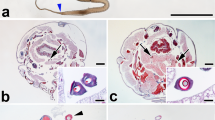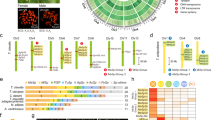Abstract
The rapid development of the silk glands of Bombyx mori during the last larval instar shows two phases. During the first 4 days, in both the middle and posterior parts of the silk glands, the ribosomal machinery is assembled and the synthesis of house-keeping proteins starts. During the second phase (the last 4 days), the middle part of the gland synthesizes ∼45 mg of the silk protein sericin (31% serine) and the posterior part of the gland synthesizes ∼130 mg of the silk protein fibroin (46% glycine, 29% alanine and 12% serine). Silk fibroin and sericin are detectable by the second day and represent 80 and 50% respectively of the total proteins produced at day 8 (refs 1–4). It is known that the tRNA population of the posterior part of the gland is quantitatively adapted to fibroin codon frequency during this period5–9 but little is known about the situation in the middle part except for the observation that it contains more tRNASer than does the posterior part. We show here that the two parts contain, and presumably use, different iso-accepting species of tRNASer, the middle part using tRNA1Ser, which recognizes AGU and AGC codons, and the posterior part using tRNA2Ser which recognizes UCA. We also suggest that this differential adaptation of the tRNASer species is under transcriptional control as the two species are accumulated at different rates, but degraded at the same rate.
This is a preview of subscription content, access via your institution
Access options
Subscribe to this journal
Receive 51 print issues and online access
$199.00 per year
only $3.90 per issue
Buy this article
- Purchase on Springer Link
- Instant access to full article PDF
Prices may be subject to local taxes which are calculated during checkout
Similar content being viewed by others
References
Daillie, J. C. r. hebd Séanc. Acad. Sci., Paris 261, 4872–4875 (1965).
Shigematsu, H. & Takeshita, H. J. Insect Physiol. 14, 1013–1024 (1968).
Tashiro, Y., Morimoto, T., Matsuura, S. & Nagata, S. J. Cell Biol. 38, 574–588 (1968).
Fournier, A. Biochimie 61, 283–320 (1979).
Daillie, J. Biol. Cell 29, 1–6 (1977).
Garel, J. P., Hentzen, D. & Daillie, J. FEBS Lett. 39, 359–363 (1974).
Chen, G. S. & Siddiqui, M. A. Q. Archs Biochem. Biophys. 161, 109–117 (1974).
Majima, R., Kawakami, M. & Shimura, K. J. Biochem., Tokyo 78, 391–400 (1975).
Garel, J. P. Nature 260, 805–806 (1976).
Gillam, I. et al. Biochemistry 6, 3043–3056 (1967).
Garel, J. P., Hentzen, D., Schlegel, M. & Dirheimer, G. Biochimie 58, 1089–1100 (1976).
Hentzen, D., Garel, J. P. & Keith, G. Biochem. biophys. Res. Commun. 71, 241–248 (1976).
Chevallier, A. & Garel, J. P. Biochimie 61, 245–262 (1979).
Garel, J. P., Garber, R. & Siddiqui, M. A. Q. Biochemistry 16, 3618–3624 (1977).
Rogg, H., Müller, P. & Staehelin, M. Eur. J. Biochem. 53, 115–127 (1975).
Chavancy, G., Chevallier, A., Fournier, A. & Garel, J. P. Biochimie 61, 71–78 (1979).
Suzuki, Y. & Brown, D. D. J. molec. Biol. 63, 409–429 (1972).
Author information
Authors and Affiliations
Rights and permissions
About this article
Cite this article
Hentzen, D., Chevallier, A. & Garel, JP. Differential usage of iso-accepting tRNASer species in silk glands of Bombyx mori. Nature 290, 267–269 (1981). https://doi.org/10.1038/290267a0
Received:
Accepted:
Issue Date:
DOI: https://doi.org/10.1038/290267a0
This article is cited by
-
Protein folding and tRNA biology
Biophysical Reviews (2017)
-
Evolutionary changes reflected by the cellular amino acid composition
Amino Acids (1999)
-
Isolation and sequence analysis of a nuclear tRNAmet-i gene from soybean
Plant Molecular Biology (1987)
Comments
By submitting a comment you agree to abide by our Terms and Community Guidelines. If you find something abusive or that does not comply with our terms or guidelines please flag it as inappropriate.



